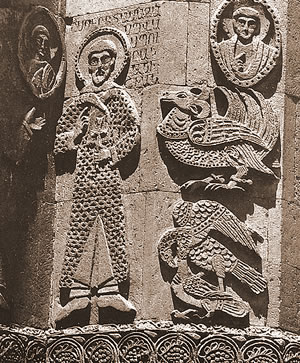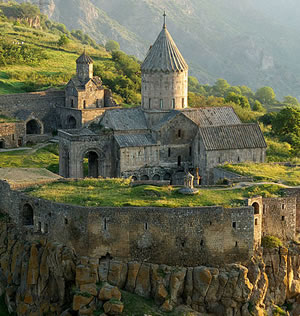Civil Strife
Sembat I
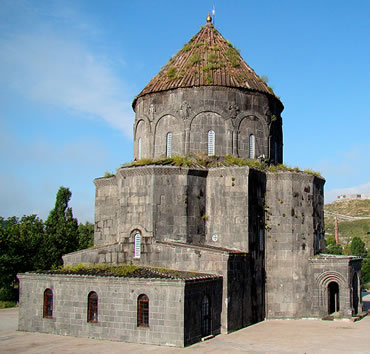 The Holy Apostles Church, or the Cathedral of Kars, was built in 939 by Abas, second son of Sembat I. Later it has been used as a mosque, a Russian orthodox church, a storage hall, and most recently, since 1998, as a mosque again. Photo Source: Wikimedia Commons
The Holy Apostles Church, or the Cathedral of Kars, was built in 939 by Abas, second son of Sembat I. Later it has been used as a mosque, a Russian orthodox church, a storage hall, and most recently, since 1998, as a mosque again. Photo Source: Wikimedia Commons
After Ashot’s death in 890 his son, Sembat I became King of Armenia. Bellicose and energetic, he waged non-stop warfare during 22 years of his ruling. He was very successful in the beginning, putting down a number of revolts in northern Armenia and subjecting the Moslem rulers of Dvin. The major Armenian Nakharars supported Sembat at that time, and his army was very efficient. But later, some of the most ambitious vassals sought independence.
As a result the Kingdom was split into several rebellious principalities. Perhaps the King Sembat had only himself to blame. He began the destructive process in 899, when he granted the title of King to his friend and loyal vassal Adrnerseh, the Prince of the vast Vyrk province. The accession of Adrnerseh in Vyrk originated the future Georgian Kingdom.
The jealousy of other influential Princes caused unrest and trouble in Armenia. The ostigan Afshin, sworn enemy of King Sembat, was now able to turn the situation to his profit. He repeatedly attacked the Armenian cities and captured the important fortress of Kars, making Armenian Queen and other members of the royal family his hostages. The truce was established after Sembat I agreed to pay a huge ransom and give one of his nieces in marriage to Afshin.
Shortly after, Afshin died, but his brother Yussouf was even worse. He concluded an alliance with Gagik Ardsrouni, ruler of Vaspurakan province. A few later, Gagik was declared King of Armenia. Also the Sparapet Ashot seceded and declared himself King of Armenia. A number of fratricidal wars devastated the country. Then Yussouf, in alliance with the apostate Armenian princes, besieged and destroyed many of key cities and fortresses. At the end of his tether, the King Sembat locked himself in an impregnable fortress of Kapuit.
The siege of Kapuit lasted over two years. Finally, Sembat surrendered to Yussuf making it a condition to spare his loyal soldiers. Yussouf hypocritically swore eternal friendship, but after a short period he perfidiously arrested the Armenian King again. Sembat I was accused of preparing a new war, tortured in a barbarous fashion, and finally put to death.
Ashot Erkat
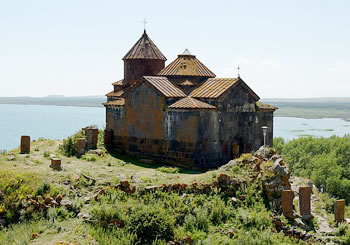 The 9th century Hayravank Monastery on the shores of Lake Sevan in Armenia. In 924, Sevan became battlefield between Ashot II and Beshir, commander of ostigan Yussuf. The victory of Ashot Erkat became a turning point in the war.
The 9th century Hayravank Monastery on the shores of Lake Sevan in Armenia. In 924, Sevan became battlefield between Ashot II and Beshir, commander of ostigan Yussuf. The victory of Ashot Erkat became a turning point in the war.
Photo Source: Alexander Naumov, Wikipedia
The internecine strife continued to destroy Armenia during the next decade. Ashot II, son of Sembat, came to throne of his father. He forthwith began the war against another King Ashot, his cousin and namesake who had for residence the city of Bagharan. The third Armenian king, Gagik Ardsrouni, ruled in relative peace the Vaspurakan province. An unprecedented renaissance in architecture marked his ruling. A number of splendid churches and a beautiful palace were built on the Akhtamar Island. Later, the Church of Holy Cross became the residence of the Catholicosate of Aghtamar.
In 914, Ashot II visited Constantinople. The Emperor Constantine VII Porphyrogenitus treated him with affection and sent him back to Armenia with a huge army. Now Ashot II was able to rout Yussouf and put an end to the Arab dominance. Historians called Ashot, Erkat i.e. Iron.
Heyday of Trade and Literature
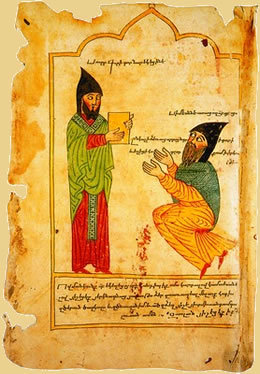 St.Gregory Narekatsi (on the left), pictured on a 1391 manuscript of his poem, Book of Lamentations
St.Gregory Narekatsi (on the left), pictured on a 1391 manuscript of his poem, Book of Lamentations
Under the ruling of Abas I, and Ashot III, Armenia reentered the period of peace and prosperity. The capital moved into the glorious city of Ani, known as “the city of one thousand and one churches”. Under the next kings, Sembat II and his brother Gaguik I, the resumption oftrade made Ani one of the most prosperous cities of that time. Its population reached 200 000 inhabitants.
The 10th and the 11th century produced new illustrious names in Armenian historical and ecclesiastic literature, such as John of Draskhanakert, Thomas Ardsrouni, Moses Kaghankatvatsi, Asoghik and Gregory Narekatsi.


